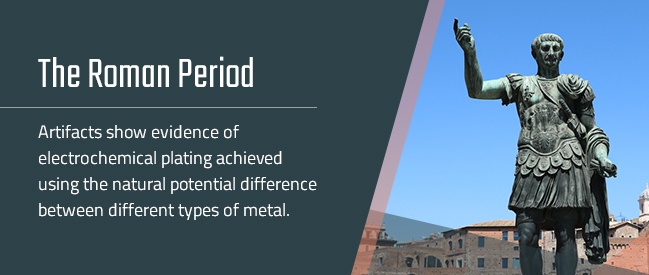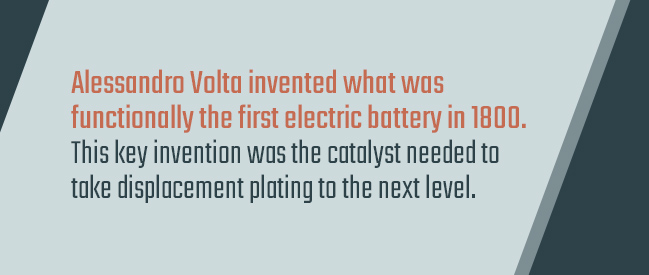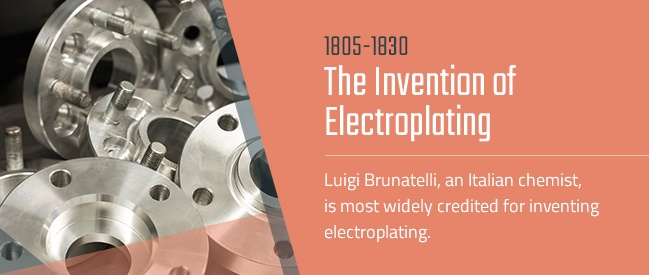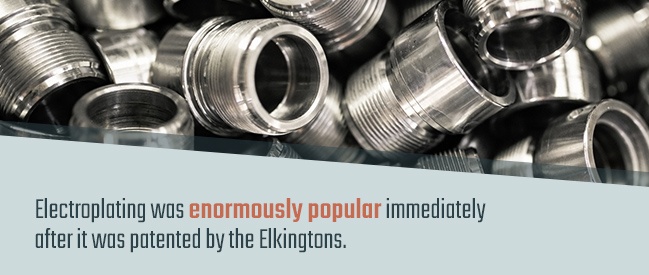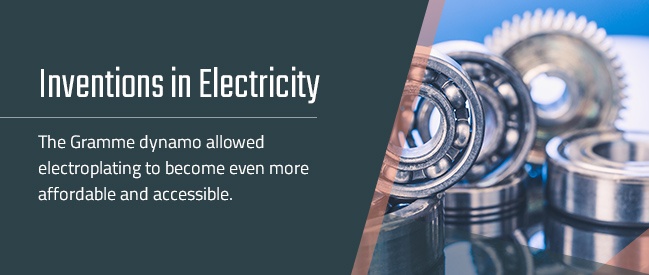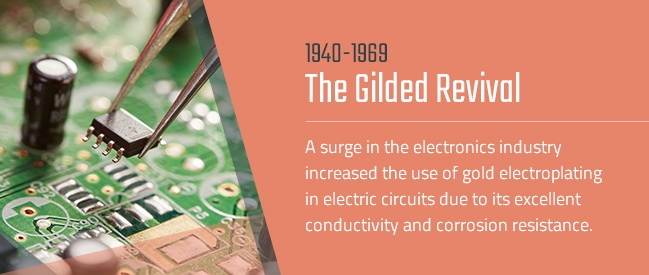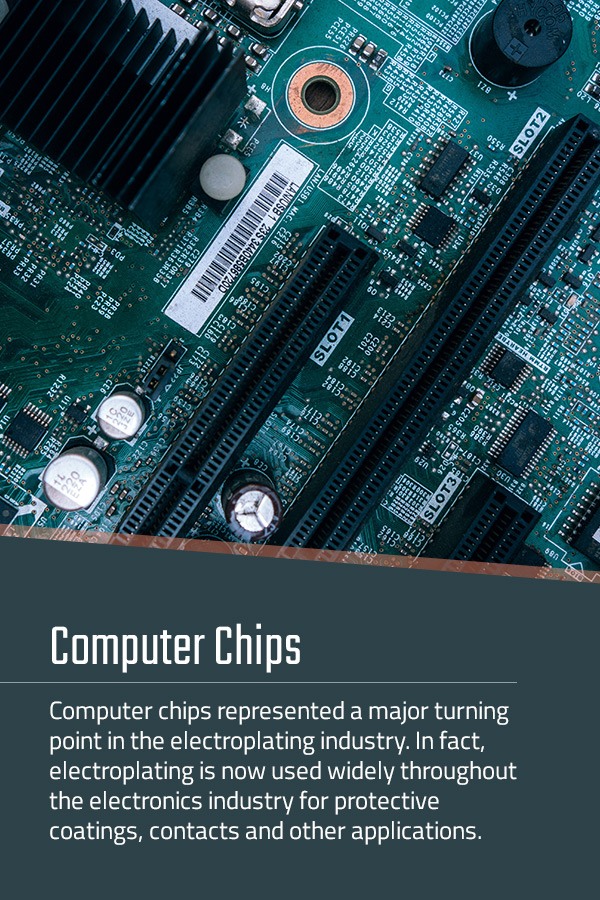
Quick Links
The Buildup to Electroplating | Who Invented Gold Plating??
The Gilded Age of Electroplating | The 20th Century Overhaul?
Modern Developments and Trends in Electroplating | Take Advantage of Electroplating Technology With SPC?
The Buildup to Electroplating
Electroplating may be the most recent way of depositing metal onto a surface, but the need to coat objects with metal has existed for thousands of years. Whether for decoration or functionality, early civilization used multiple methods to apply metal to surfaces, with their techniques and efforts eventually leading to the development of electroplating. The key periods and associated practices are listed below:
- Bronze Age: The Bronze Age lasted from the fourth through the second millennium BCE. While corrosion has made it difficult to accurately date the finishing techniques discovered, archaeologists estimate that the first instances of metal inlays date from the third millennium BCE. In these finds from the Middle East and Egypt, metal foil and wire were inlaid into grooves, wrapped around or crimped onto objects to change their physical appearance. Over time, the layers seem to have gotten thinner, with finds from the second millennium BCE using metal leaf instead of foil to decorate statues.
- Iron Age: The Iron Age lasted from the 12th to the fifth century BCE and saw the first instances of complete plating of objects, achieved in ancient Greece by applying metal foil and wire around an entire object.
- Roman Period: The Romans appear to be the first to use displacement plating to coat objects. In the Early Roman period between the first and fourth century CE, artifacts show evidence of electrochemical plating achieved using the natural potential difference between different types of metal. Another coating method, mercury gilding, was developed around the same time. Though mercury gilding was invented Central Asia, Pliny the Elder was the first to describe the process in the first century CE. In this process, also called fire gilding, small pieces of gold were mixed with mercury in a one-to-eight ratio, creating a viscous amalgam that could be brushed onto the surface of a substrate. Once complete, the object was then heated until the mercury vaporized, leaving behind the gold plating. This technique was also called the Lost Apprentice Technique because the process created toxic mercury fumes, which, when combined with poor ventilation, resulted in mercury poisoning that destroyed the sanity of and then killed gilders after about four coatings.
- Medieval Period: The medieval period between the fifth and 15th centuries saw an expansion of techniques developed during the Roman Period. In the ninth century, Europeans developed displacement plating techniques for iron armor, which plated the surface of the armor with copper to prepare it for mercury gilding. Damascene was also developed during this period, named after Damascus, Syria, where it was most commonly seen. This inlay technique involved cutting a design into a substrate metal, then cutting and hammering a decorative metal into the substrate. False damascene was also developed, which uses a similar process but involves scoring the substrate metal instead of cutting into it.
- Renaissance: The Renaissance period from the 15th to the 17th century saw further development of displacement plating — clock dials, for example, were plated with silver using silvering salts as pastes and solutions.
- Industrial Revolution: While previous techniques used displacement plating and set the groundwork for the development of electroplating, the true origin of electroplating came during the Industrial Revolution, which took place between the late 18th and early 19th century. Alessandro Volta invented what was functionally the first electric battery in 1800. Named after Volta, the voltaic pile stacked galvanic cells to produce an electric current. Volta’s invention was lauded by French Emperor Napoleon Bonaparte, who made Volta a count for his work. This key invention was the catalyst needed to take displacement plating to the next level, which occurred shortly after Volta’s invention.
Who Invented Gold Plating?
After Volta invented and published his findings on his electrochemical batteries, many people began to experiment with the technique to discover new applications. It was in the subsequent decades that electroplating was born. However, there are several important names and events associated with the invention and initial development of electroplating — the major time periods and events are described below:
- 1800-1804: Cruikshank first describes electroplating. British scientist William Cruickshank first reported on electroplating in 1801. In his publication, Cruickshank described his experiment of depositing dendritic metallic lead and copper onto a surface using Volta piles. Cruickshank achieved this by attaching silver wires to the top and bottom layers of the Volta pile and placing the ends in an acetate solution, then a copper solution in subsequent experiments. As a result, fine needles of metallic material deposited on the bottom of the volta pile. However, while Cruickshank’s experiment was the first reported incident of electroplating, he is not credited with the invention of electroplating, since the technique wasn’t fully explored for another couple of years.
- 1805-1830: Brugnatelli invents electroplating. Luigi Brunatelli, an Italian chemist, is most widely credited for inventing electroplating. Brugnatelli published his findings on the use of Volta piles to deposit a layer of gold onto a metallic surface in 1805. Using a similar technique to that used by Cruickshank, Brugnatelli plated gold onto silver medals by submerging them in an “ammoniuret of gold” and applying a charge using a Volta pile. The Belgian Journal of Physics and Chemistry published his findings, but his work was not well-received in the wider scientific community. While Napoleon celebrated Volta’s, the French Emperor disapproved of Brugnatelli’s work. In Napoleon’s view, this discovery would make gold plating accessible to the lower class, which was unacceptable in his opinion. Napoleon’s disapproval subsequently barred Brugnatelli’s work from the French Academy of Sciences, preventing it from reaching the wider scientific community.
- 1830-1840: The Elkingtons patent several electroplating processes. After Brugnatelli’s effective silencing, electroplating was largely forgotten for decades. The process didn’t resurface until the 1830s, when several scientists rediscovered it independently. In 1839, Russian and British inventors developed processes to electroplate copper printing plates, and British inventor John Wright realized he could use potassium cyanide as an electrolyte for electroplating. In 1840, Wright began working with the Elkington cousins, George and Henry, who bought Wright’s patent and received several more for similar electroplating processes using gold and silver. The Elkingtons found commercial success plating silverware and manufacturing decorative products, including the flatware aboard the RMS Titanic when it sank.
With the efforts of these and more individuals, electroplating finally broke into the scene. Very quickly, it was clear that electroplating was perfectly poised to take over the market due to the trends of the Industrial Revolution combined with the rise of the British Empire.
The Gilded Age of Electroplating
Electroplating was enormously popular immediately after it was patented by the Elkingtons. By the 1850s, Elkington & Co. had experienced widespread success due to the popularity of plating various surfaces with gold, silver, copper and other metals. But why did the Elkingtons prevail where Brugnatelli failed, and why was electroplating it so immediately popular? There are several reasons:
- Newly rich populations: With the Industrial Revolution came a new wealthy class, made so by the expansion of factories and the abundance of work opportunities in cities. It became fashionable to show off this wealth by any means necessary, and the ornate styles of the recent Baroque and Rococo periods seemed fitting. Products reminiscent of these stylistic periods could be made more cheaply using manufacturing techniques and electroplating, making them more widely affordable and accessible.
- Russian aristocracy: While Western Europe’s masses clamored to get plated products, Russia experienced a similar rush for gold electroplating among its religious and economic elite. The Eastern Orthodox Church invested heavily in gilded icon cases, statues and other decorations for their churches, while the Romanov royal family showed off their enormous wealth with gold plated items throughout their properties.
- Inventions in electricity: In 1871, Belgian inventor Zénobe Gramme created a direct current generator that used rotary motion. The Gramme dynamo allowed electroplating to become even more affordable and accessible, with an increasing number of electroplating businesses cropping up across Europe.
- Expansion of the British Empire: The late 19th century saw a huge expansion of the British Empire across the world, and electroplating quickly followed wherever the Empire went. The spread of British culture, inventions and fashions also spread the popularity of electroplated items to populations that otherwise wouldn’t have used the technology.
While these factors allowed electroplating to flourish very quickly in the 19th century, several problems arose that hindered its growth. Most notable among these was the fact that electroplating was considered a trade, not a science. As a result, plating formulas and processes were considered trade secrets and were closely guarded. This jealous hoarding of information prevented ideas and research from freely passing between producers, making electroplating processes unreliable and irreproducible. This practice continued throughout the 19th century and into the early 20th century, resulting in a decline of quality and innovation in the electroplating industry.
The 20th Century Overhaul
By the beginning of the 20th century, the electroplating industry had effectively come to a standstill — industry leaders refused to share information, scientists barely understood the process, and innovation was practically nonexistent. However, the 20th century was a time of change for many industries, and electroplating was no exception.
- 1900-1913: Electroplating becomes a science. To remedy the current problems facing the electroplating industry, the American Electrochemical Society, the predecessor of The Electrochemical Society, held a symposium in 1913 regarding the electrodeposition of metals. The Society hired Francis C. Frary and gave him a grant to compile all recipes relating to the plating of gold and silver using electrolytic processes. By the end of his research period, Dr. Frary had compiled 193 recipes from German, French, British and American sources, all of which were presented and published. This publication marked a turning point in the history of electroplating, marking the point where electroplating became a science rather than a trade secret.
- 1914-1939: The world ignores electroplating. Despite the fact that electroplating had become more reproducible, the practice fell out of favor with the world at large. The new middle class had grown used to their wealth and no longer tried to show it off with gilded decorations, and the Soviet revolution ended the excesses of the Romanov family. In the following decades, wars and economic depressions further reduced the popularity of gold electroplating on the wider market, as the industry focused instead on supporting the war effort.
- 1940-1969: The Gilded Revival. In the 1940s, the electroplating process changed significantly for the first time since Wright patented it. A surge in the electronics industry increased the use of gold electroplating in electric circuits due to its excellent conductivity and corrosion resistance. The increase in popularity prompted scientists to develop safer, more effective electroplating methods that didn’t use the dangerous cyanide baths used in previous decades. As a result, the industry replaced its cyanide baths with safer acid baths and started using gold electrolytes with no excess cyanide.
The progress of electroplating continued through the remainder of the 20th century and into the 21st, with particular focus placed on safety as well as an expansion of electroplating applications. The current age, the Silicon Age, officially began in 1970 and has seen the continued evolution of electroplating. Electroplating in the 1970s evolved toward safe water disposal in the face of environmental concerns while simultaneously upgrading associated hardware to help streamline the process. This helped the electroplating industry grow in size and scope, expanding the technology to a wide range of applications.
Modern Developments and Trends in Electroplating:
The old aesthetic applications of gold electroplating are still widely applicable in the modern world — in fact, the Elkington plating company still produces gold plated dinnerware. However, the continued development of technology within both the electroplating industry and the wider market has resulted in many electroplating opportunities that Brugnatelli couldn’t have possibly imagined when he first developed the technology in 1805. Some of the most notable developments are listed below:
- Computer chips: Computer chips represented a major turning point in the electroplating industry. IBM started using electroplating in the production of computer chips in the 1970s, as well as damascene techniques. This use of electroplating expanded over the subsequent decades, with gold electroplating being used on electrodes in fuel cells and on circuit board contacts as well as computer chips. In fact, electroplating is now used widely throughout the electronics industry for protective coatings, contacts and other applications. Further developments may see electroplating applied to even more advanced technologies, including nanotechnology.
- Electroless plating: While displacement plating has been around since the Roman period, electroless plating in a wider sense is a significantly newer development. While the subject had been studied in the mid-19th century, Abner Brenner and G.E. Riddell accidentally rediscovered electroless plating in 1944 while researching how to plate the inside of machine gun barrels. By experimenting with different levels of current, substrate, additives and other factors, they eventually discovered that nickel could be plated without electricity by using sodium hypophosphite as a source of electrons. Brenner published his findings in 1948, and electroless plating has since been used to deposit nickel, cobalt, copper, silver, gold or similar metals onto various substrates for a wide range of applications.
- Non-metal substrates: Plating onto non-metal substrates is another recent development that has gained a great deal of popularity due to its ability to instill fragile components with the physical and mechanical properties of metals. Some examples of non-metal substrates that can be plated include glass, plastic, ceramic and Kevlar. Many industries choose to plate these materials to achieve specific results — for example, the automotive industry often plates plastic to achieve lower car weights without sacrificing finish quality. When the plating process is complete, these plated materials are stronger, more durable, and more resistant to corrosion, making them more valuable to a variety of industries.
These developments are incredible and have made for massive changes in the industry at large. To make the most of these technologies, however, businesses need to work with plating companies that know electroplating from the inside out. Sharrett’s Plating Company can help.
Take Advantage of Electroplating Technology With SPC
Contemporary electroplating technologies look very different from the gilding techniques used centuries ago — the lethal gold mercury fire gilding process of the Roman period was replaced by the toxic gold-cyanide electroplating process of the Industrial Revolution, which again gave way to the reproducible, safer plating processes developed in the 20th century. From black art to trade secret to reproducible science, electroplating has undergone several evolutions over its long and storied history, and it will continue to evolve into the future.
Keep up with ever-changing electroplating processes with an industry leader that’s been plating for decades. Since 1925, Sharrett’s Plating Company has been providing industrial plating services to a wide range of industries, constantly updating our processes to meet the most recent standards and technological advances. From palladium plating to electroless nickel plating, our industrial plating capabilities include everything your company needs to succeed.
We offer customized plating and metal finishing services so that our customers can develop high-quality products while reducing their overall operating costs. From copper, silver and gold plating to metal alloy plating, we provide you with all the materials and maximum flexibility to get your job done. We can also handle a wide range of substrates — SPC is one of the few plating companies in the industry that can effectively alloy metals such as gold and nickel with titanium, and we have extensive experience plating metal onto plastics, ceramics and other non-metal substrates.
On top of it all, we are one of the most environmentally friendly metal plating services in operation, constantly working to improve our metal plating and finishing processes to preserve the environment while maximizing efficiency.
With SPC, you can trust that our services are as reliable and affordable as possible, no matter your industry or application. If you want to learn more about any of our services or the future of electroplating, we are ready to help. Contact us today for a free quote on your next product, and one of our customer service representatives will get back to you within a single business day!


